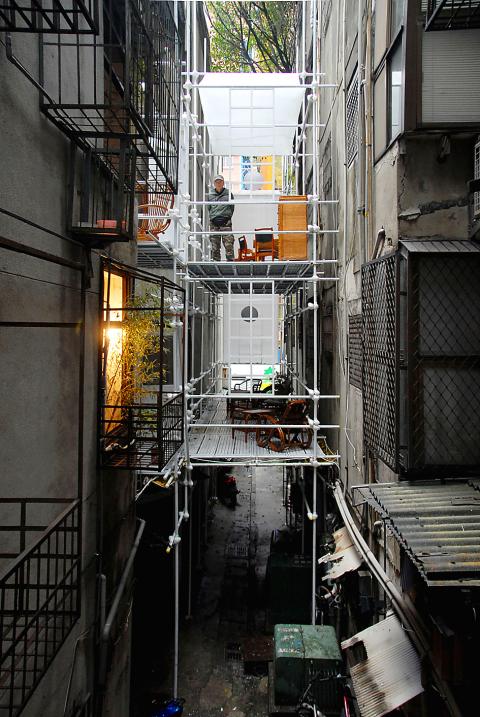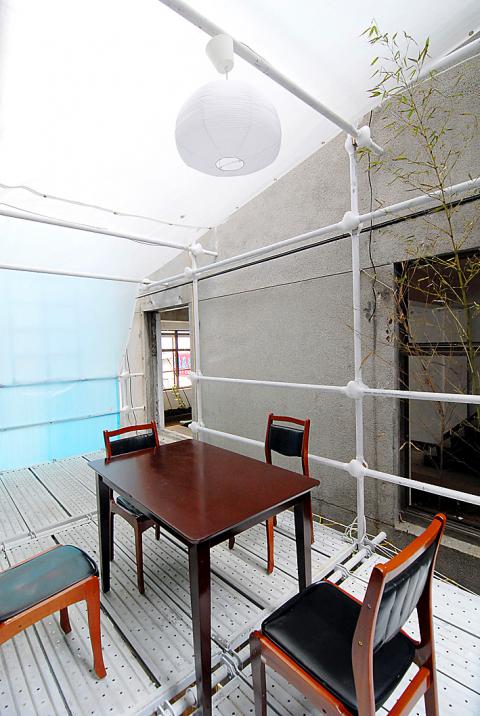If you’ve ever rented a rooftop apartment in Taiwan, chances are your landlord was breaking the law — many of the structures are illegal.
For curator and architect Roan Ching-yueh (阮慶岳), these illegal rooftop apartments are the site of a struggle between the average citizen on the one side and the government, developers and architects on the other. This tension lies at the heart of Illegal Architecture (朗讀違章), an exhibit of documents and installations that examines the architecture and architectural practices of Taiwan’s Hsieh Ying-chun (謝英俊) and China’s Wang Shu (王澍).
“The design of most modern cities is top-down. The interesting thing about the development of Asian cities is that it is bottom up. It is very organic,” Roan told the Taipei Times over coffee at the trendy UrbanCore Cafe and Bookshelf, which is located in the same part of a drab cement building as UrbanCore Gallery, where the exhibit’s documents are located.

Photo Courtesy of JUT Foundation for Arts and Architecture
“But the Taipei government has been trying to change that, trying to control everything with order,” he said. “I think it is really scary. But I think we can learn from unregulated architecture. It is something we should be proud of.”
Roan’s solution isn’t to build more illegal structures, but to involve residents and local architects in the modification of existing ones.
“For example, the rooftops for the whole block, you could build a bridge linking them and an elevator from ground level up. You can create another layer in the city,” he said.

Photo Courtesy of JUT Foundation for Arts and Architecture
Roan cited two books that inspired the current show and informed his own thinking about architecture since he gave up his practice a decade ago to pursue teaching, writing and curating.
The first, The Hidden Order: Tokyo Through the Twentieth Century by Yoshinobu Ashihara, presents a picture of Tokyo that challenged architectural orthodoxy at the time of its publication in 1989.
“Before 1989, the thinking went that Asian cities were behind [architecturally],” Roan said. “But his book showed that Asian cities have an order — but it is a hidden order.”

Photo Courtesy of JUT Foundation for Arts and Architecture
Taken as a whole, Tokyo — and indeed Taipei — might appear chaotic, but order emerges, Roan said, when we examine the organic nature of how buildings develop in Asian cities.
The second and perhaps more revolutionary book to influence Roan was Made in Tokyo, a somewhat eccentric work that is part guidebook, part rumination on Tokyo’s architecture.
Published in 2001, it launched an assault on the rarefied presumptions of the architecture industry as seen through magazines, which generally focus on single structures by well-known architects.
“The architecture you see in these magazines is a lie because you rarely see it in ordinary life. It is architecture that is detached from reality,” Roan said.
Made in Tokyo broadened Roan’s ideas about architecture’s potential because it focused on the often overlooked functional buildings and tiny structures that make up the majority of Tokyo’s urban environment.
Illegal Architecture merges these two strands of thought and presents Asian cities as possessing their own internal logic of organically created local architecture, which is favored over bureaucratically sanctioned and developer-imposed ideals.
For Roan, Hsieh and Wang’s work exemplifies architecture that takes communities into account and is organic, practical and sustainable.
Roan first met Wang at the 10th International Architecture Exhibition at the 2006 Venice Biennale. At the time, Roan was curating Taiwan’s pavilion, which included works by Hsieh. Roan said he was drawn to Wang and Hsieh because both emphasize the importance of local labor, local building practices and local building materials in the construction of new buildings.
In 2010, Wang won an award for The Decay of a Dome (衰變的穹頂), a large-scale canopy-like dome installation made from short pieces of wood, at the 12th Venice Biennale. Illegal Architecture presents his Squarely Sphering. Built without nails, the work, which takes the shape of a tunnel, was designed to be placed on a rooftop.
Located around the corner from Wang’s dome is Hsieh’s Arcadia in a Back Alley (後巷桃花源). He uses steel scaffolding and planks to fill an alley with living, sleeping and eating quarters.
“Building technology is intentionally made difficult so that only a limited number of people can control the knowledge,” Roan said. By presenting the work of Hsieh and Wang, he aims to show that the know-how and materials needed to build constructions are readily available to non-experts.
As I spoke to Roan, it occurred to me that some people might not want their neighbors trying their hand at knocking up architectural constructions.
But more problematic than that, perhaps, is the role of the exhibition’s organizer, JUT Foundation for Arts and Architecture (忠泰建築文化藝術基金會). The cultural arm of JUT Living Development (忠泰生活開發股份有限公司), a major developer in Taiwan (the company owns the buildings where the gallery, coffee shop and installations are located), it has spearheaded similar exhibits, such as last year’s Urban Crack (城市隙縫), which was curated by Sean Hu (胡朝聖).
It seems odd that an organization associated with the type of architecture that seems at odds with the ideals of Wang and Hsieh would be responsible for putting on Illegal Architecture.
Still, for Roan, the very idea that JUT is open to this kind of exhibit is a step in the right direction. Illegal Architecture is about creating a dialogue among Taipei’s citizenry, developers and architects, which he hopes will influence government policy.

June 23 to June 29 After capturing the walled city of Hsinchu on June 22, 1895, the Japanese hoped to quickly push south and seize control of Taiwan’s entire west coast — but their advance was stalled for more than a month. Not only did local Hakka fighters continue to cause them headaches, resistance forces even attempted to retake the city three times. “We had planned to occupy Anping (Tainan) and Takao (Kaohsiung) as soon as possible, but ever since we took Hsinchu, nearby bandits proclaiming to be ‘righteous people’ (義民) have been destroying train tracks and electrical cables, and gathering in villages

Dr. Y. Tony Yang, Associate Dean of Health Policy and Population Science at George Washington University, argued last week in a piece for the Taipei Times about former president Ma Ying-jeou (馬英九) leading a student delegation to the People’s Republic of China (PRC) that, “The real question is not whether Ma’s visit helps or hurts Taiwan — it is why Taiwan lacks a sophisticated, multi-track approach to one of the most complex geopolitical relationships in the world” (“Ma’s Visit, DPP’s Blind Spot,” June 18, page 8). Yang contends that the Democratic Progressive Party (DPP) has a blind spot: “By treating any

Swooping low over the banks of a Nile River tributary, an aid flight run by retired American military officers released a stream of food-stuffed sacks over a town emptied by fighting in South Sudan, a country wracked by conflict. Last week’s air drop was the latest in a controversial development — private contracting firms led by former US intelligence officers and military veterans delivering aid to some of the world’s deadliest conflict zones, in operations organized with governments that are combatants in the conflicts. The moves are roiling the global aid community, which warns of a more militarized, politicized and profit-seeking trend

This year will go down in the history books. Taiwan faces enormous turmoil and uncertainty in the coming months. Which political parties are in a good position to handle big changes? All of the main parties are beset with challenges. Taking stock, this column examined the Taiwan People’s Party (TPP) (“Huang Kuo-chang’s choking the life out of the TPP,” May 28, page 12), the Democratic Progressive Party (DPP) (“Challenges amid choppy waters for the DPP,” June 14, page 12) and the Chinese Nationalist Party (KMT) (“KMT struggles to seize opportunities as ‘interesting times’ loom,” June 20, page 11). Times like these can